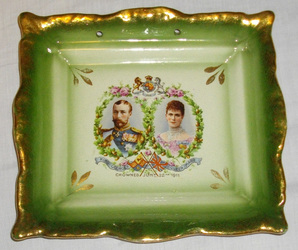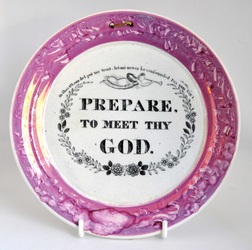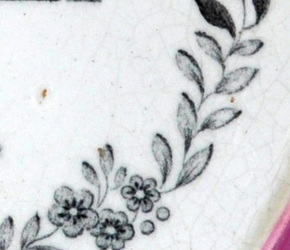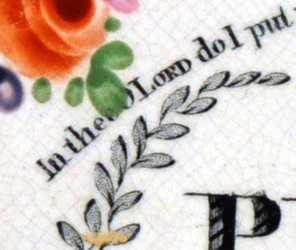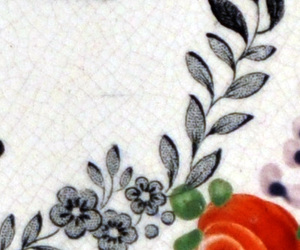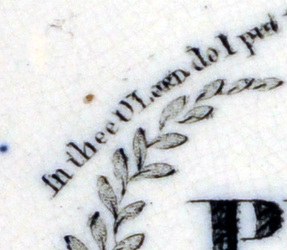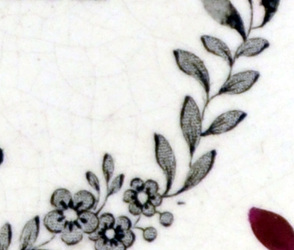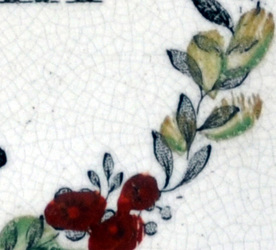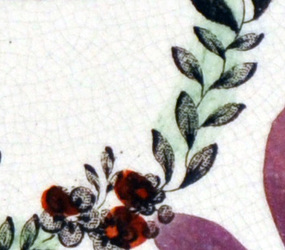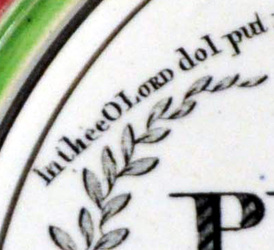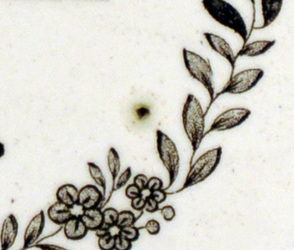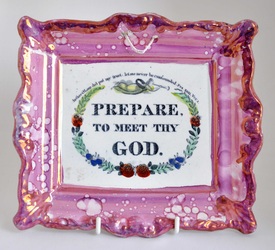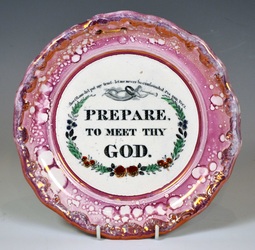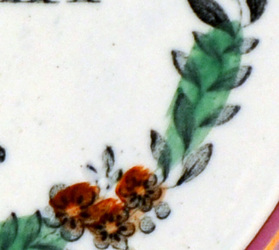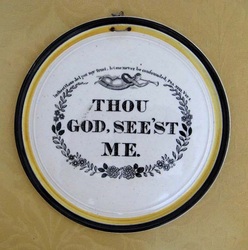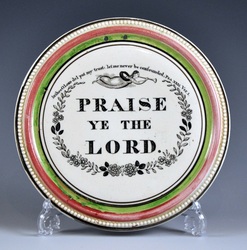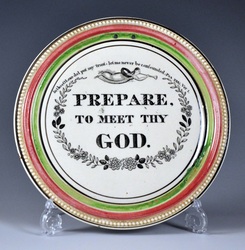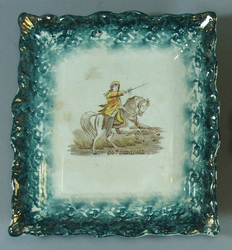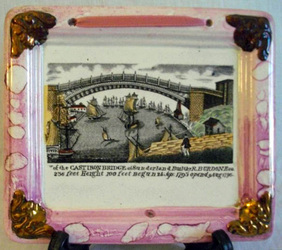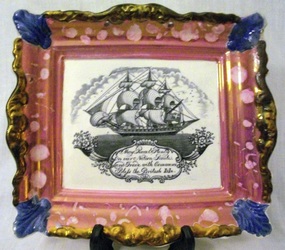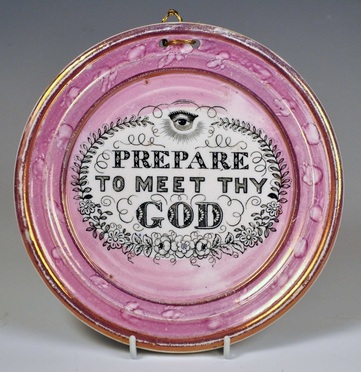|
2/24/2011 0 Comments Start a websiteIan Holmes has set up a website with a great page of Staffordshire plaques: http://unitedcollections.weebly.com/plaques.html. There is also a series of pages dedicated to Jack Crawford (right below), and a page of lifeboat-related pottery (left below), so plenty to interest Sunderland lustre collectors. If you're a serious collector, the chances are your partner's on the verge of a breakdown (oh no, not another crenulated Edwardian stomach pump), your friends roll their eyes when you tell them about your eBay purchases, and your work colleagues think you're every bit as mad as the woman in HR with six cats. Starting a website helps you reach out to like-minded people, who will deceive you into believing collecting is a rational activity.
And it's easy and costs nothing. All you need is a digital camera. Take a look at www.weebly.com, and learn how to build a website for free. Here are some more great pottery-related websites: Myrna Schkolne's www.mystaffordshirefigures.com is a fabulous reference site, with well-researched information and professional quality photos of early Staffordshire figures. Even if figures aren't your thing, you'll find it fascinating. And where else are you going to get the latest insights of a published expert for free? The Staffordshire Figure Association runs a site www.staffordshirefigureassociation.com that has a chatty newsletter style, and puts Staffordshire collectors in touch with each other. The Sunderland site has a wealth of information about all things Sunderland, including the potteries and engravings of the bridge over the River Wear. The enthusiast who put the site together lives in Canada, and has never been to Sunderland! Myrna once said to me, 'Imagine if every collector did this'. And she's right, the internet would be an amazing place.
0 Comments
I had the idea that if you arranged details of all the Scott-attributed 'Prepare' plaques in columns (the ones with 'thee' in the top verse), one plaque above another, you'd be able to put them in chronological order, depending on where they belonged in terms of the life cycle of the transfer plate, i.e. I expected a graduated fading of the imprint, and then points of refreshment where re-engraving occurs. When ordering the photos, I considered the following points:
This first plaque is attributed to Newbottle c1830s (see my previous post). The imprint is bolder because the deeper grooves of the newly engraved transfer plate hold more ink. The next two plaques could either be Newbottle or Scott. Baker writes that Newbottle produced pink lustre wares. But my guess is they are later in form and belong to the Scott era, c1840s. They probably post date the two plaques below them, as the imprint is fainter, i.e. the grooves on the transfer plate have worn shallow and hold less ink. The two forms below are Scott-attributed, and appear with other Scott transfers, e.g. Cast Iron Bridge over the River Wear, and the Mariner's Compass. At this point, my chronology fell flat. No matter how hard I tried to arrange the sequence of transfers, I could find no evidence for the change in the shading of the leaves being due to re-engraving. The first plaque below is almost certainly 1830s, and yet, unlike the plaques above, the leaves on the left of the sprig are shaded most heavily on their left side (see right column photos). So the following plaques were produced FROM A DIFFERENT TRANSFER PLATE. The seven plaques that follow are indisputably from the same copper plate, as they all have an identical flaw – a small horizontal mark to the right of the third flower (see right column photos). The first plaque is from an unknown pottery, though could possibly be Scott. All the others are plaque forms associated with Scott. Note that the next two plaque forms also appear in the section above with the 'Newbottle' transfer plate. So the two transfer plates were in use simultaneously on the same plaque forms. The four plaques below are of the brown-bordered variety most commonly attributed to Scott (c1850s-c1870s). For anyone thinking, phew, well that's all sorted now, think again. The two items below don't fit either of the transfer prints above. In the centre column of photos, note the shading of the leaf under the 't' in 'thee'. In both cases its most heavily shaded on the left side. That isn't true for any of the plaques above. Note that even though the leaves are shaded similarly (in the third column photos) to the plaques above, neither the plaque nor the bowl below has the transfer flaw to the right of the flower. So we started off with two sets of Scott transfer plates ('the' and 'thee') and now have at least four! And what about the fabulous circular red-and-green-bordered plaque (see below) I mentioned in my last post? Like the two Scott items above, the leaf under the 't' in 'thou' is shaded on the left side (so it's not Newbottle), and it doesn't have the flaw to the right of the flower. This morning I had an inspiration and remembered the two circular Moore & Co plaques from 'The Bottle' series, which are of this form. Satisfyingly, the transfer on the red and green plaque is an excellent match to those on the plaques I'd attributed to Moore & Co. Paradoxically, the marked Scott bowl, which I used as a basis for attributing brown-bordered plaques to Scott, appears to have a Moore & Co transfer! This doesn't, however, damage the attribution too much as there are Scott-marked bowls with ships and other transfers that appear on brown-bordered plaques.
So, back in the 1830s an enterprising engraver made at least four sets of transfer plates of these verses for the Sunderland potteries, apparently based on those used by C,C & Co in Newcastle. Scott seems to have, over time, acquired at least three of the sets. Perhaps partly to increase production, but surely also to monopolise the lucrative market in these verses. Re-engraving and restoration of the transfer plates, doesn't play as great a part as I thought, despite the long production period of these plaques. When one set of engravings wore thin, Scott could simply switch production to another. I think this is why the 'Newbottle' set doesn't appear on post-c1850s plaques, i.e. why there are no brown-bordered plaques with that transfer. Someday, when I feel stronger, I ought to take a closer look at the 'Thou gods'! 2/20/2011 0 Comments Plaques attributed to NewbottleIn my February 13th blog post, I talked about Scott 'commissioning' two sets of transfer plates (Prepare... Thou... & Praise...) – one with 'In the O Lord...' and the other with 'In thee O Lord' in the verse above the trumpeting angel. The word 'the' appears on small fine plaques of the 1830s, on which the Wesley and Clarke transfers associated with Scott also appear. The word 'thee', however, doesn't appear on Scott-attributed items until c1845. There's one scenario I hadn't considered. What if Scott commissioned only one set of transfer plates in the 1830s (with the word 'the'), but at the same time, the engraver made another set of copper plates (with the word 'thee') for another pottery? Then, at a later date, because of the popularity of the verses, Scott somehow managed to acquire this second set. So is there any evidence the 'thee' transfers were used before c1845? Stephen Duckworth drew my attention to the 'Praise ye the lord' plaque in the V&A on-line collection (see below right). At first glance it looks similar to the Cornfoot, Colville & Co plaques of the late 1820s, but the pottery never made plaques with that verse. The plaques below are, in fact, from the 'thee' transfer set, which would later be used by Scott. Interestingly, all three plaques have faults of execution, with thumb prints and bleeding to the glaze of the black outer border. The V&A attributes their 'Praise' plaque to 'Newbottle'. To me, until now, this seemed fanciful, as the plaque bears no maker's mark. But this weekend I reread Baker's 'Newbottle Potteries' chapter and found the following (p44): "The Victoria and Albert Museum have in their collections the following examples given by Mr W H Fairbairns in 1905: Vase, with lid, decorated with painted design of trees and cottages in pink lustre; circular plaque with religious motto, "Praise ye the Lord", and a broad band of copper lustre on rim; glazed, moulded earthenware figure of a goat; a bust of John Wesley; a child's plate with daisy pattern embossed rim and central transfer of a girl holding a bird; a set of three children's plates with embossed rims with mottoes, each with a differing transfer design and verse, and general title, 'Flowers That Never Fade'. The attribution of this wide range of pottery to Newbottle has been questioned, despite the fact the donor was a descendent of the owners of the 'High' Pottery and presumably had knowledge of its products. The children's pottery plates in particular would normally be regarded as Staffordshire products, yet a sherd of wasted plate uncovered from Newbottle in 1980 showing a fragment of 'Flowers that Never Fade is evidence that such pottery was, in fact, made in Newbottle and probably at other Wearside potteries." It seems that Baker made an error in describing the border of the plaque as having a 'broad band of copper lustre'. But remember, in 1984 when he revised and edited his book, the descriptions couldn't be checked through a 10-minute internet search! Click here to see the items that come up if you search the V&A catalogue for Newbottle. You'll note they are all gifts of W H Fairbairns. So how did the transfer plates arrive at Scott's Southwick Pottery? Anthony Scott managed the 'High' Newbottle Pottery until 1788, when he and his father set up their pottery in Southwick. After that Robert Fairbairns took over the management of the 'High' Pottery, and continued until John Broddick acquired it sometime between 1841 and 1851 (Baker). This change of ownership, therefore, seems the most likely reason for the transfer plates moving to Scott. The date range fits perfectly. It perhaps makes sense that with the Newbottle link, Fairbairns should sell the transfer plates to Anthony Scott (who died in 1847). So are there any other recorded plaques with these transfers that fit the Newbottle era (c1830–c1845)? The three plaques below are very fine, and could belong to the Newbottle period of production. Below is a comparison of the two 'prepare' plaques above, with the 'prepare' attributed to Scott c1845 (right column of photos). The centre, Newbottle-attributed plaque, and the Scott-attributed plaque are certainly from the same transfer plate. The plaque on the left is very slightly different. As noted in my January 30th blog post, the leaves on the left of the sprig are more heavily shaded on the left side (see bottom row of photos). This variation occurs amongst the plaques attributed to Scott, and I've put it down to re-engraving of the transfer plate over time. Interestingly though, the plaques with shading on the left of the leaves tend to be later, like the brown-bordered plaques, c1850s onwards. And yet, if I'd had to guess, I would have said the circular plaque was older. So either these red and green circular plaques continued to be made later than was previously supposed, or there's a third variation of this transfer plate.
2/15/2011 0 Comments Still no surrender!Please read my previous blog post first. Brettells Auctions listed the pair of plaques below as 'Two rectangular Sunderland lustre plaques', proving that even professional cataloguers are not always completely accurate in their descriptions. The 'No surrender' transfer differs from that in my previous post, but is also likely Staffordshire. Though this version is less common than the one on eBay, the two plaques above sold today for hammer price £120. Most of the value of the lot was in the c1840–50's 'May Peace and Plenty' plaque. So, for more or less the price of the plaque sold on eBay, you could have a rarer variation AND a 19th century Sunderland lustre original.
2/14/2011 3 Comments No surrender!Ian Holmes e-mailed me about a plaque which sold on eBay yesterday for £127.50. The description read: RARE ANTIQUE SUNDERLAND LUSTRE PLAQUE DEPICTING WILLIAM OF ORANGE - WITH THE MOTTO - NO SURRENDER THIS IS A FINE ANTIQUE PLAQUE - DATING CIRCA 1820 Ian said the inaccuracies in the description were 'typical of a seller who has no other proper lustre items,' and added '...clearly people are thinking this is not just a Staffordshire 1890s piece. Sad.' I wrote to the eBay seller a few days ago and told him his description was way off. Being less charitable than Ian, I estimated the plaque to be of early 20th century production. At any rate, it's not particularly rare, not Sunderland lustre, and certainly not 1820. The seller didn't respond (never mind amend the description). So if you've just purchased this item and want to keep it, you should feel no qualms about asking for £100 refund from the sale price. P.S.The seller has written to me to say he hadn't received my e-mail, sent through eBay's 'ask a question'. He found it in his spam filter. There has been a happy outcome in that he has offered the buyer a full refund.
In my January 9th blog post, I said it didn't seem logical that Scott of Southwick would have commissioned two sets of transfer plates (Prepare... Thou... & Praise...) – one with 'In the O Lord...' and the other with 'In thee O Lord' in the verse above the trumpeting angel. We know that transfer plates were valuable, because they were sold on after potteries closed, and carefully restored by flattening out and re-engraving. So why would one pottery go to the expense of producing two sets of almost identical transfer plates, and use them simultaneously on different wares? And yet, both sets of transfers have strong links to Scott. Below are the plaque forms with 'the' in the verse. The Wesley transfer, particular to Scott (or Southwick), appears on all of these plaque forms. The next group of plaques all have 'thee' in the verse. They are attributed to Scott on the basis that transfers of ships etc on brown-bordered plaques, like the one below right, also appear on plates and bowls with the 'SCOTT' impress. The next three plaques show that it isn't just religious verses that link these three plaque forms. The left plaque below has white edges showing from the front, like the one above it. The centre plaques, above and below, are of a smaller, plainer rectangular form. The right plaques, above and below, are the large brown-bordered plaques most commonly attributed to Scott. The Mariner's Compass also appears on all these three plaque forms. But are there any transfers that link the 'the' group with the 'thee' group of plaques? Take a look below. The plaque on the left is of the type with white edges showing from the front, and belongs to the 'thee' group of plaque forms. The plaque on the right belongs to the 'the' group. Likewise, the brown-bordered plaque below belongs to the 'thee' group, and the orange plaque with rounded corners to the 'the' group. So if all the above plaques are Scott, why would he have commissioned two sets of verse transfers, one with 'the' and one with 'thee'? And why weren't they both used on all of the Scott-attributed plaque forms? These questions might be linked to perhaps the greatest plaque mystery of all: why are there so many transfers which commonly appear on jugs and bowls but never on plaques? Scott's Southwick Pottery was large, with 152 workers (in 1861) spread over a sprawling site of inter-connecting buildings (see Baker, fig 48, p49). What if different areas were set up for producing different lines of pottery? Jugs and bowls in one place, plates and plaques in another. Perhaps one set of plaque moulds were kept in one area, and another set somewhere else. If transfers were printed close to where the enamels were fired, transfer plates might have been location-specific too.
'Prepare to meet thy god', 'Thou god seest me' and 'Praise ye the lord', were the most popular plaques. Maling produced 'Prepares' and 'Thous' from 1817, and they were still in production at Ball's Deptford Pottery at the turn of the 20th century. So economically speaking, it might have made perfect sense to have two sets of transfer plates for use at different ends of the pottery. It would have doubled Scott's capacity to produce his best-selling plaques. So perhaps not so illogical after all. I'm under no illusions regarding the number of 'what ifs' in my reasoning above. As always, I'd love to be told how and why I've got it wrong (though being told I'd got it right would obviously be better!). The first plaque below is of a type that until recently I hadn't noticed existed. It has the 'Prepare' transfer that appears on plaque forms attributed to Scott (click here to read my previous post on the subject). Ian Holmes drew my attention to this 'family' of finely potted plaques, which have very neatly applied copper lustre borders, painted up to a line, so that the white edges of the plaque are visible from the front (see detail below – click to enlarge). The detail is from the 'May Peace and Plenty' plaque to its right. At first glance it could be mistaken for a Garrison (Dixon) plaque (see bottom left). But the plaques are different sizes. The plaque with white edges showing is 230mm x 200mm, whereas the Garrison plaque is 210mm x 185mm. Bottom centre, is a blue-cornered 'May Peace and Plenty' with white edges showing. The 'white edges' plaques are close in size to the common brown-bordered plaques attributed to Scott (bottom right), which are 230mm x 205mm. The brown-bordered plaques are, however, much more heavily potted. Below are three details. The first is from the Garrison plaque (bottom left, above), and the second from the plaque with white edges showing (top right, above). They are clearly from different transfer plates. Another difference is that the triangular pennant flag on the centre mast is much shorter on the Garrison version. The 'white edges' plaques come from the same transfer plate as the brown-bordered plaques commonly attributed to Scott (see below right detail). In case you needed more convincing regarding a Scott attribution, the three plaques below, with white edges showing, all have transfers that appear on other plaques forms attributed to Scott. For the reasons set out in my last 'Prepare' blog post, I think these plaques pre-date the clunky brown-bordered plaques of the 1850s and 60s. N.B. I've yet to see a 'white edges' plaque with a Crimean ship. So my guess is that they are more refined precursors of the brown-bordered plaques, and were made by Scott in the 1840s. P.S.I've added a new May peace and plenty page under the maritime section. I dream that one day someone with a large collection of maritime plaques will get in touch!
2/6/2011 0 Comments MSTP is 1 year oldMate Sound The Pump is a year old. Google tells me the site has had 4431 visits from 1909 visitors, from 67 countries worldwide, 43 US states, and 266 UK cities. A huge thank you to everyone for taking, on average, 5 minutes and 24 seconds, per visit, to look. To mark the anniversary, I've posted another 200 images across the website. Some of the most interesting are from my recent re-visit to Elinor Penna's amazing collection in New York. Elinor collects and deals in the Victorian pottery I love – Staffordshire figures, Sunderland lustre, bargeware... Thank you Elinor for your hospitality. Here are some personal highlights below. Towards the end of January is New York Antiques Week. So there were familiar British faces in the US at the Ceramics Fair – Martyn Edgell, John Howard and Philip Carrol – all of whom occasionally have plaques. And I met some great US natives – Peggy Sutor, Bill Shaeffer and Rick Hall – selling Staffordshire at the Pier Show. There were some impressive lustreware jugs offered by Malcolm Magruder and Dennis and Dad Antiques, and a good selection of children's plates etc at Leatherwood Antiques. I even managed to find an affordable plaque (below) from Virginia Newell, which came back to the UK with me. Thanks again to everyone who has contributed to the site. The gaps look a little smaller a year on. But there are still many, many plaques to be recorded. If you have even just one of them, please get in touch.
|
AuthorStephen Smith lives in London, and is always happy to hear from other collectors. If you have an interesting collection of plaques, and are based in the UK, he will photograph them for you. Free advice given regarding selling and dispersal of a collection, or to those wishing to start one. Just get in touch... Archives
February 2022
AcknowledgementsThis website is indebted to collectors, dealers and enthusiasts who have shared their knowledge or photos. In particular: Ian Holmes, Stephen Duckworth, Dick Henrywood, Norman Lowe, Keith Lovell, Donald H Ryan, Harold Crowder, Jack and Joyce Cockerill, Myrna Schkolne, Elinor Penna, Ian Sharp, Shauna Gregg at the Sunderland Museum, Keith Bell, Martyn Edgell, and Liz Denton.
|

